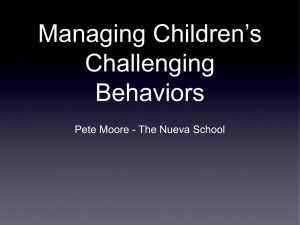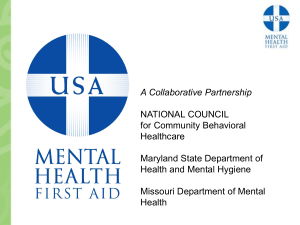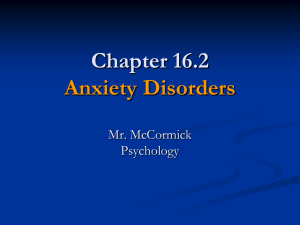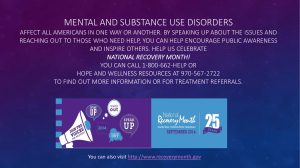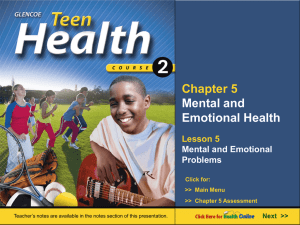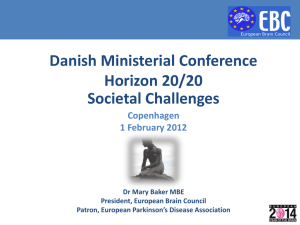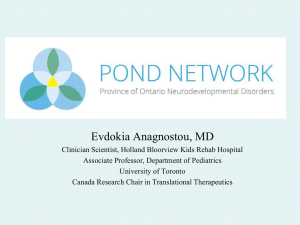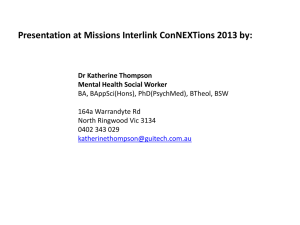Chpt_13_Psychologica..
advertisement
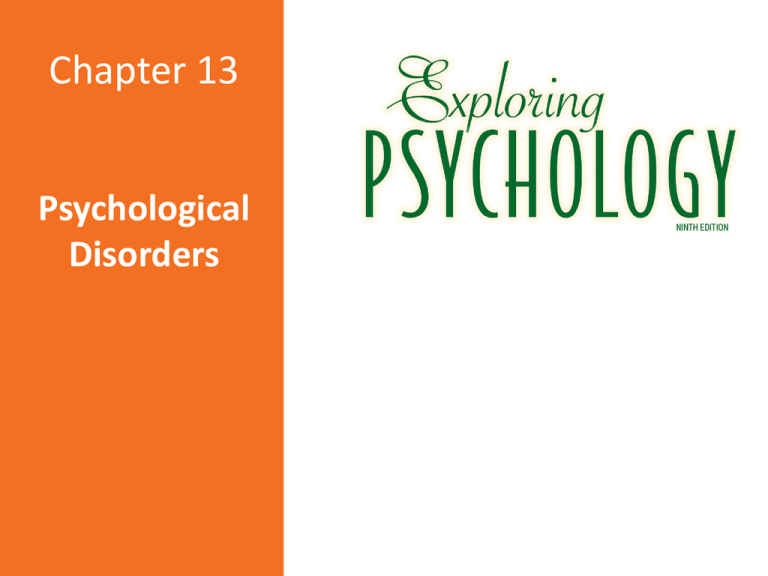
Chapter 13 Psychological Disorders Why should you care... • An estimated 26.2 percent of Americans ages 18 and older—about 1 in 4 adults—suffer from a diagnosable mental disorder in a given year. • Major depressive disorder affects approximately 14.8 million American adults. • Nearly twice as many _________as ________ suffer from major depressive disorder each year. • In 2006, 33,300 (approximately 11 per 100,000) people died by suicide in the U.S • Four times as many men as women die by suicide; however, women attempt suicide two to three times as often as men. What we’ll seek to understand... What does it mean to have a mental disorder? Defining and classifying disorders Anxiety disorders, including GAD, Panic, Phobias, OCD and PTSD Mood disorders, including depression and bipolar disorder Schizophrenia Sample of other disorders: Dissociative disorders Eating disorders Personality disorders Rates of Diagnosis with Disorders Rates of Psychological Disorders This list takes a closer look at the past-year prevalence of various mental health diagnoses in the United States. Perspectives on Psychological Disorders Defining psychological disorders Understanding psychological disorders Classifying psychological disorders Labeling psychological disorders Questions to Keep in Mind How do we decide when a set of symptoms are severe enough to be called a disorder that needs treatment? Can we define specific disorders clearly enough so that we can know that we’re all referring to the same behavior/mental state? Can we use our diagnostic labels to guide treatment rather than to stigmatize people? A Psychological disorder is: _____________________________________ _________________________________ More Disorders are diagnosed when there Understandings is dysfunction, behaviors which are considered maladaptive because about disorders: they interfere with one’s daily life Disorders are diagnosed when the symptoms and behaviors are accompanied by Distress, suffering. New definition (DSM 5): “a disturbance in the psychological, biological, or developmental processes underlying mental functioning.” The ____________ The discovery that the disease of syphilis causes mental symptoms (by infecting the brain) suggested a medical model for mental illness. Psychological disorders can be seen as psychopathology, an illness of the mind. Disorders can be diagnosed, labeled as a collection of symptoms that tend to go together. People with disorders can be treated, attended to, given therapy, all with a goal of restoring mental health. A Counter Argument: The Myth of Mental illness Thomas ___________ • Not all mental illnesses are diseases as defined by the medical model • There are no objective ways to test or measure behavior • Diagnoses are not diseases • A way to classify and control “undesirable behavior” • Two Historic Examples • ___________________- “the uncontrollable urge to escape slavery” • Homosexuality- was viewed as a mental illness just 30 years ago Classifying Psychological Disorders Why create classifications of mental illness? What is the value of talking about diagnoses instead of just talking about individuals? 1. Diagnoses create a verbal shorthand for referring to a list of associated symptoms. 2. Diagnoses allow us to statistically study many similar cases, learning to predict outcomes. 3. Diagnoses can guide treatment choices. The Diagnostic and Statistical Manual It’s easier to count cases of autism if we have a clear definition. Versions: DSM-IV-TR, DSM-V (May 2013) The DSM is used to justify payment for treatment. It’s consistent with diagnoses used by medical doctors worldwide. Critiques of Diagnosing with the DSM 1. The DSM calls too many people “disordered.” 2. The border between diagnoses, or between disorder and normal, seems arbitrary. 3. Decisions about what is a disorder seem to include value judgments; is depression necessarily deviant? 4. Diagnostic labels direct how we view and interpret the world, telling us which behavior and mental states to see as disordered. 5. Creates distorted view of normalcy in professionals • ______________ Experiment Anxiety Disorders: Our self-protective, risk-reduction instincts in overdrive Panic Disorder: Fear of the next attack Phobias: Don’t even show me a picture OCD: I know it doesn’t make sense, but I can’t help it PTSD: Stuck Reexperiencing Trauma Causes of Anxiety Disorders: Fear Conditioning Observational Learning Genetic/Evolutionary Predispositions Brain involvement Panic Disorder: “I’m Dying” A panic attack is not just an “anxiety attack.” It may include: many minutes of intense dread or terror. chest pains, choking, numbness, or other frightening physical sensations. a feeling of a need to escape. _____________________refers to repeated and unexpected panic attacks, as well as a fear of the next attack. ___________________ A __________________is more than just a strong fear or dislike. A specific phobia is diagnosed when there is an uncontrollable, irrational, intense desire to avoid the some object or situation. uncontrollable, irrational, intense desire to avoid the object of the phobia. Common OCD Behaviors Percentage of children and adolescents with OCD reporting these obsessions or compulsions: Howie Mandel Video Howard Hughes Aviator Clip Common pattern: RECHECKING Although you know that you’ve already made sure the door is locked, you feel you must check again. And again. Post-Traumatic Stress Disorder _________ About 10 to 35 percent of people who experience trauma not only have burned-in memories, but also four weeks to a lifetime of: repeated intrusive recall of those memories. nightmares and other reexperiencing. social withdrawal or phobic avoidance. jumpy anxiety or hypervigilance. insomnia or sleep problems. Which people develop PTSD? Those with sensitive emotion-processing limbic systems Those who are asked to relive their trauma as they report it Those previously traumatized Biology and Anxiety: Genes Studies show that identical twins, even raised separately, develop similar phobias (more similar than two unrelated people). Some people seem to have an inborn highstrung temperament, while others are more easygoing. Temperament may be encoded in our genes. Genes and Neurotransmitters Genes regulate levels of neurotransmitters. People with anxiety have problems with a gene associated with levels of serotonin, a neurotransmitter involved in regulating sleep and mood. People with anxiety also have a gene that triggers high levels of glutamate, an excitatory neurotransmitter involved in the brain’s alarm centers. Biology and Anxiety: The Brain Traumatic experiences can burn fear circuits into the amygdala; these circuits are later triggered and activated. Anxiety disorders include overarousal of brain areas involved in impulse control and habitual behaviors. The OCD brain shows extra activity in the ACC, which monitors our actions and checks for errors. ACC = anterior cingulate gyrus Biology and Anxiety: An Evolutionary Perspective 1. Human phobic objects: 2. Similar but non-phobic objects: Snakes Fish Heights Low places Closed spaces Open spaces Darkness Bright light 3. Dangerous yet non-phobic subjects: We are likely to become cautious about, but not phobic about: Guns Electric wiring Cars Evolutionary psychologists believe that ancestors prone to fear the items on list #1 were less likely to die before reproducing. There has not been time for the innate fear of list #3 (the gun list) to spread in the population. Criteria of Major Depressive Disorders Major depressive disorder is not just one of these symptoms. It is one or both of the first two, PLUS three or more of the rest. _________________________________________ _________________________________________ Significant increase or decrease in appetite or weight Insomnia, sleeping too much, or disrupted sleep Lethargy, or physical agitation Fatigue or loss of energy nearly every day Worthlessness, or excessive/inappropriate guilt Daily problems in thinking, concentrating, and/or making decisions Recurring thoughts of death and suicide An Evolutionary Perspective on the Biology of Depression Depression, in its milder, nondisordered form, may have had survival value. Under stress, depression is social-emotional hibernation. It allows humans to: conserve energy. avoid conflicts and other risks. let go of unattainable goals. take time to contemplate. Biology of Depression: Genetics Evidence of genetic influence on depression: 1. DNA linkage analysis reveals depressed gene regions 2. twin/adoption heritability studies Suicide and Self-Injury Every year, 1 million people commit suicide, giving up on the process of trying to cope and improve their emotional well-being. This can happen when people feel frustrated, trapped, isolated, ineffective, and see no end to these feelings. _______________________has other functions such as sending a message, distracting from emotional pain, giving oneself permission to feel, or selfpunishment. ____________: Psychosis refers to a mental split from reality and rationality. the mind is split from reality, e.g. a split from one’s own thoughts so that they appear as hallucinations. Schizophrenia symptoms include: disorganized and/or delusional thinking. disturbed perceptions. inappropriate emotions and actions. Positive and Negative Symptoms of Schizophrenia __________ presence of problematic behaviors Hallucinations (illusory perceptions), especially auditory Delusions (illusory beliefs), especially persecutory Disorganized thought and nonsensical speech Bizarre behaviors __________ absence of healthy behaviors Flat affect (no emotion showing in the face) Reduced social interaction Anhedonia (no feeling of enjoyment) Avolition (less motivation, initiative, focus on tasks) Alogia (speaking less) Catatonia (moving less) Subtypes of Schizophrenia Paranoid • Plagued by hallucinations, often with negative messages, and delusions, both grandiose and persecutory Disorganized • Primary symptoms are flat affect, incoherent speech, and random behavior Catatonic • Rarely initiating or controlling movement; copies others’ speech and actions Undifferentiated • Many varied symptoms Residual • Withdrawal continues after positive symptoms have disappeared Eating Disorders Anorexia nervosa Bulimia nervosa Binge-eating disorder These may involve: unrealistic body image and extreme body ideal. a desire to control food and the body when one’s situation can’t be controlled. cycles of depression. health problems. Definition Prevalence Compulsion to lose weight, 0.6 percent Anorexia coupled with certainty about being meet criteria at Nervosa fat despite being 15 percent or some time more underweight during lifetime ____________ Compulsion to binge, eating large ____________ amounts fast, then purge by losing 1.0 percent the food through vomiting, laxatives, and extreme exercise Binge-Eating Compulsion to binge, followed by 2.8 percent guilt and depression Disorder Eating Disorders: Associated Factors Family factors: having a mother focused on her weight, and on child’s appearance and weight negative self-evaluation in the family for bulimia, if childhood obesity runs in the family for anorexia, if families are competitive, high-achieving, and protective Cultural factors: unrealistic ideals of body appearance __________________________________ Persistently acting without conscience, without a sense of guilt for harm done to others (strangers and family alike). The diagnostic criteria include a pattern of violating the rights of others since age 15, including three of these: Iceman Video Clip Deceitfulness Disregard for safety of self or others Aggressiveness Failure to conform to social norms Lack of remorse Impulsivity and failure to plan ahead Irritability Irresponsibility regarding jobs, family, and money Biosocial Roots of Crime: The Brain People who commit murder seem to have less tissue and activity in the part of the brain that suppresses impulses. Other differences include: less amygdala response when viewing violence. an overactive dopamine reward-seeking system. Case Examples • Julie, a 24 year old office manager came to see me complaining that she is constantly fearful that her home will be robbed. As a result of her fear, Julie routinely locks all the doors and windows in her home and checks the locks upwards of twenty times. Julie reports that even when she is at work she cannot help but constantly think about her home being robbed. • _________________________________ Case Examples • Maria brought her nine year old son Marcos to my office last week. Maria is concerned that Marcos has been constantly arguing with her and openly refusing to follow her instructions. Marcos has also displayed this disobedient behavior at school with his teacher. He is easily angered and purposely tries to spite or annoy his mother. • ________________________________ Case Examples • Joanne is a seventeen year old who was referred to my clinic for odd eating behaviors. When I interviewed Joanne I could tell she was very obsessive about her weight. I noted in my assessment that her weight fell in the normal range for a young girl her age. Joanne revealed to me that she frequently ate excessively large meals to the point she would feel ill. She would later secretly induce herself to vomit. • _________________________________ Case Examples • A colleague of mine told me about the case of 27 year old Michael. Michael was a former legal clerk who was convinced that he was under surveillance by the CIA. He was difficult to understand because he spoke with no logical organization to his speech. He reported that the CIA had implanted a device in his ear which was designed to command him to reveal secret legal documents. Michael was soon referred to a psychiatrist for a psychiatric evaluation. • _________________________________
